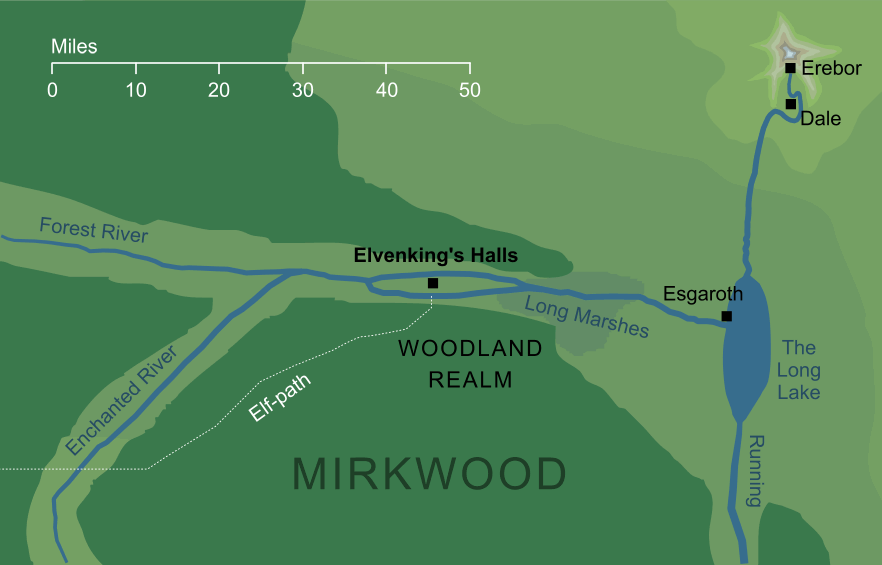- Cities and buildings
- Fields, plains and deserts
- Forests
- Hills and mountains
- Islands and promontories
- Lands, realms and regions
- Rivers and lakes
- Seas and oceans


 |
||||||
|
|
|
Dates
Probably built in the mid- to late Third Age1
Location
Northeastern Mirkwood, on the banks of the Forest River
Origins
Race
Division
Culture
Indexes: About this entry:
|
Elvenking’s HallsThe stronghold of the Woodland Realm
The location of the Elvenking's Halls (somewhat conjectural)2
The location of the Elvenking's Halls (somewhat conjectural)2
When the Shadow fell on Greenwood the Great in the Third Age, the Silvan Elves of that forest withdrew northward. Near the Forest's northeastern fringes, on the banks of the Forest River, Thranduil built an underground fortress for himself and his people. He was inspired in this enterprise by Thingol's halls of Menegroth in Doriath during the First Age, and like Thingol he used the skill of the Dwarves to aid in making his stronghold, though the Elvenking's Halls of Mirkwood were less grand than that magnificent ancient cavern. Thranduil's Halls were not a home for his entire people, who spent most of their time in the open woodlands, but they served as a palace, a treasury and a stronghold. They were built within a cavern on the Forest River's banks, whose entrance was protected by magical stone door and reached by a bridge across the river. Within were a maze of passageways and chambers, including Thranduil's throne room. As in Thingol's Menegroth, the roof of the throne room was supported by pillars carved from the living rock. Deep within the Halls were the Elvenking's dungeons, in which he held the Dwarves of Thorin's company for a time during the Quest of Erebor. These Dwarves were aided in their escape by Bilbo Baggins, using the power of the Ring to remain invisible while he devised a plan of escape. Beneath the Halls, a stream of the Forest River ran, which was used for trade with the nearby Men of the Long Lake. The Dwarves escaped from the Halls using a trapdoor that led down into this stream, the only other exit apart from the impassable stone doors. Seventy-six years later, these same dungeons were used to hold Gollum for a time, before he was also able to make his escape. Notes
See also...Indexes: About this entry:
For acknowledgements and references, see the Disclaimer & Bibliography page. Original content © copyright Mark Fisher 2009. All rights reserved. For conditions of reuse, see the Site FAQ. Website services kindly sponsored by Discus from Axiom Software Ltd.Leadership is a focus of a Discus team report, looking at a leader's style and the team's needs. |